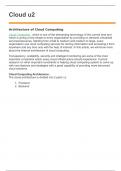Class notes
CloudComputingLearning
- Course
- Institution
Explore this comprehensive set of notes on cloud computing, covering fundamental concepts, key technologies, and practical applications. These notes delve into topics such as cloud service models (IaaS, PaaS, SaaS), deployment models (public, private, hybrid), virtualization, security in the cloud,...
[Show more]



